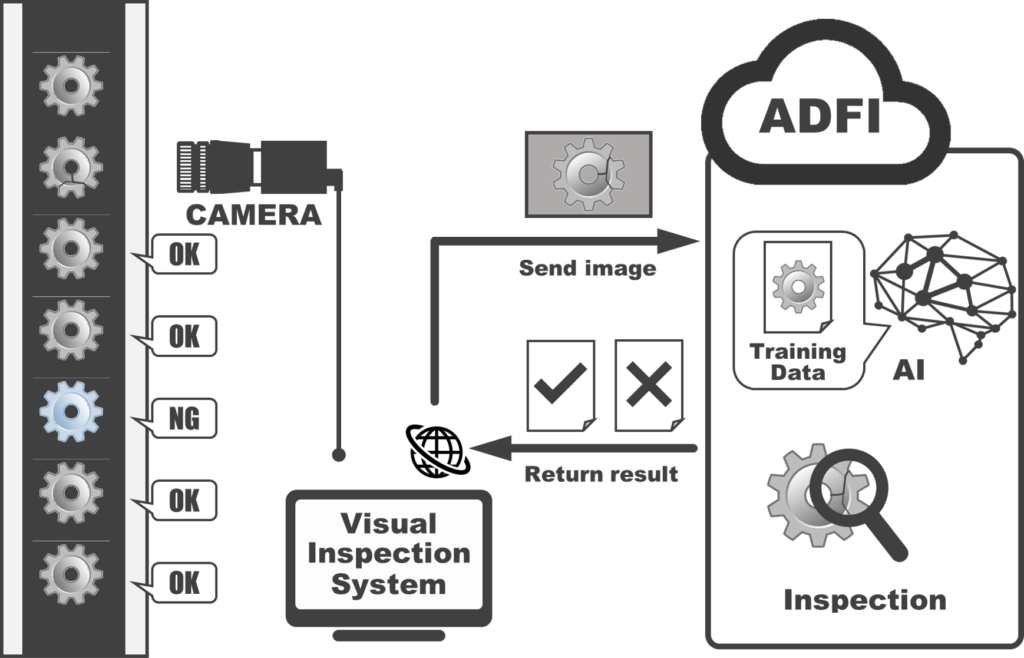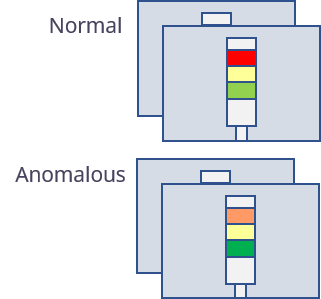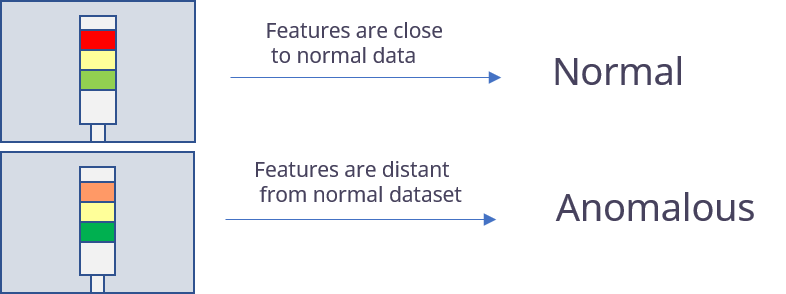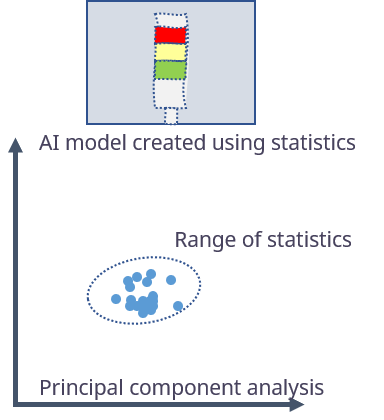Chapter 0. Overview of service
0-1. Service utilization concept
ADFI provides a service on the cloud, and thus can be used by connecting to the Internet.
Since communication is done via HTTPS, the ADFI API (Application Programming Interface) can be used safely and securely.
When an image to be inspected is sent to the ADFI API from a visual inspection system linked with a control PC or PLC (Programmable Logic Controller) of production equipment, the inspection result is returned in real-time.

Note 1) An API is an interface for communicating and linking with external applications.
Note 2) PLCs are the most common type of controller used in production equipment. They generally use ladder logic, but if you want to use ADFI, please use a product that allows use of an API (e.g., one that allows programming in C).
0-2. Items to be prepared by the user
- A PC or PLC connected to the network and capable of executing an API
- Inspection images for training and testing (normal/anomalous)
Corresponding extension: .jpg, .jpeg, .png - Vision camera and lighting for capturing the inspected object
0-3. Differences between PCA-MSPC and DML
ADFI offers two services: DML (Deep Metric Learning) and PCA-MSPC (Multivariate Statistical Process Control based on Principal Component Analysis) . These use different AI model algorithms.
DML enables anomaly detection even in cases that are difficult to handle with conventional image processing technology (e.g., cases where the position of the inspected object is not fixed). This is a new deep learning technique suited to anomaly detection.
PCA-MSPC is an AI algorithm suitable for situations where the position of the inspected object is fixed within the image or where there is no variation in object shape. At present, this anomaly detection technique is widely used in areas such as manufacturing industries.
[Number of images needed for learning and requirements]
| DML | PCA-MSPC | ||
|---|---|---|---|
| Minimum number of images | Normal image | 20 images | 10 images |
| Anomalous image | 5 images | - | |
| Recommended number of images | Normal image | 50 - 200 images | 30 - 60 images |
| Anomalous image | 10 - 50 images | Unnecessary | |
| Maximum image size | No limitations (Within ADFI, images are automatically resized to 800x800 pixels or less) | ||
| Conditions of inspected object | No conditions | Fixed position and shape | |
Note) There are no limitations on the size of images that can be uploaded. Uploaded images are automatically resized to 800×800 pixels or less within ADFI.
Please select the AI model to be used by following the flowchart below.

<DML>
[From learning to testing]
| Learning | Normal images and anomalous images are used for learning. To accurately perform anomaly detection, data on likely anomalies must be included in learning.  |
| Learning results | Based on the learned normal data and anomalous data, the system extracts the features of each, and maps the data onto a space so that the normal data items are close to each other, and anomalous data items are separated. |
| Judgment | Normal/anomalous judgment is done based on where an item is classified in the mapping of the created AI model. The mapping distance for determining anomaly is adjusted using a judgment threshold.  |
[Specific examples where anomaly detection is possible]
| Anomaly category | Specific examples |
|---|---|
| Color of object changes | Inspection for discoloration or soiling Inspection for cloth fraying or knit twisting Cracks or paint peeling in bridges/structures Inspection for roughness of grain surface Harness wiring color inspection Inspection for cracked eggs |
| Shape of object changes | Checking fastening of caps of PET bottles and other bottles Food product breakage, damage, chipping Molded part burrs or chips Solder inspection Dents in screw threads Tearing of food product wrapping paper O-ring insertion inspection Inspection of weld shape |
| Presence of object | Admixture of foreign matter Presence of food products/ingredients Presence of air bubbles |
Compared with PCA-MSPC, there are fewer limitations on position and shape, and the algorithm can be used with food products, cables, and other products/fabrics with irregular shapes.
Sometimes DML can achieve anomaly detection when detection is impossible with PCA-MSPC.
<PCA-MSPC>
[From learning to testing]
| Learning | Learning is done with normal images only. |
| Learning results | An AI model is created using principal component analysis. |
| Judgment | Normal/anomalous judgment is done based on whether the image is within range or deviated from the created AI model. Range size is adjusted using judgment thresholds.  |
The larger the variation from normal images, the more accurately anomaly detection can be done.
If you want to detect anomalies based on more subtle differences, either enlarge images so the differences are clearly evident, or use DML.
[Specific examples where anomaly detection is possible]
| Anomaly category | Specific examples |
|---|---|
| Color of object changes | Monitoring of signal towers Color code inspection Inspection of printed text quality Inspection of shift in label position |
| Shape of object changes | Inspection for bent or missing pins of electronic components Scratch/dent inspection Wafer inspection |
| Presence of object | Admixture of foreign matter Presence of label |
0-4. Service usage plans and payment methods/times
Usage plans can be selected for each dataset.
To change a usage plan, start from “Plan” in the dataset.
The Free Plan can be used for 30 days after creating a dataset. If you do not change from the Free Plan to a fee-based plan, the dataset will be automatically deleted when 30 days have passed.
[Service plan details]
| Plan | Free Plan | Pay-Per-Use Plan | Flat-Rate Plan |
|---|---|---|---|
| AI model creation and its performance verification | ✅ | ✅ | ✅ |
| Run AI model in your local environment | ✅(Up to 90 days) | ✅ | ✅ |
| Run AI model in online (ADFI cloud) environment | ✅(Up to 300 images) | ✅ | - |
| GPU-equipped hardware | Unnecessary | Unnecessary | Unnecessary |
| Time required to obtain AI model result | - | 2-3 seconds / image | 0.2 seconds / image |
| Usage fee | Free | 0.02 US$ / image (*) Minimum fee is $6 / month * HR-DML: 0.03 US$ | 600 US$ / month |
| Payment method | - | Credit card | Credit card |
| Available period | 1 year from last login | Unlimited (automatically updated every month) | Unlimited (automatically updated every month) |
API use limit setting: A monthly limit can be set on the number of times data is sent/received with the API.
Alert send setting: Monthly alert notifications can be set for the number of times data is sent/received with the API. Alerts are sent to the stored email address.
Note 1) Credit card information must be stored to change from the Free Plan to a fee-based plan.
Note 2) The only payment method available is credit card payment.
Note 3) Fee-based plans are charged for one month at 23:00 (UTC) on the first day of each month. Please note that the Light plan and Standard plan cannot be calculated on a daily basis. For example, even if you sign up for Standard plan at the end of the month, you will be charged for one month.
0-5. Use procedure
- Register as a user
- Create a project
- Create a dataset
- Store training images and create an AI model
- Store test images, and set judgment threshold for the AI model
- Increase the number of test images, verify the created AI model and judgment threshold, and complete the AI model
- Copy the API code, and implement in a program
- Execute the API from the program
The time from user registration to use of the ADFI service from the API can be as short as 1 hour.
0-6. Screen composition
